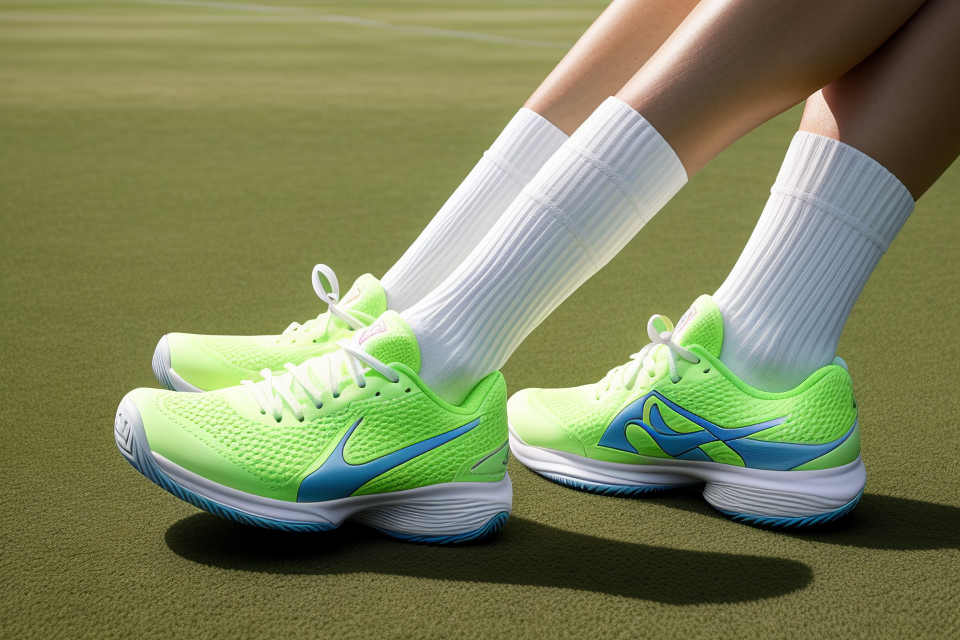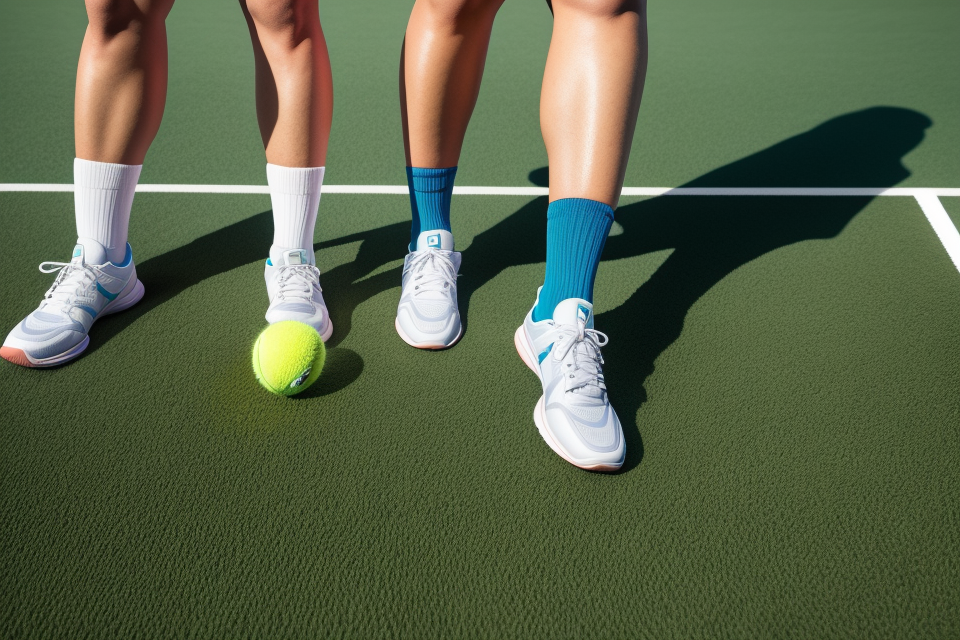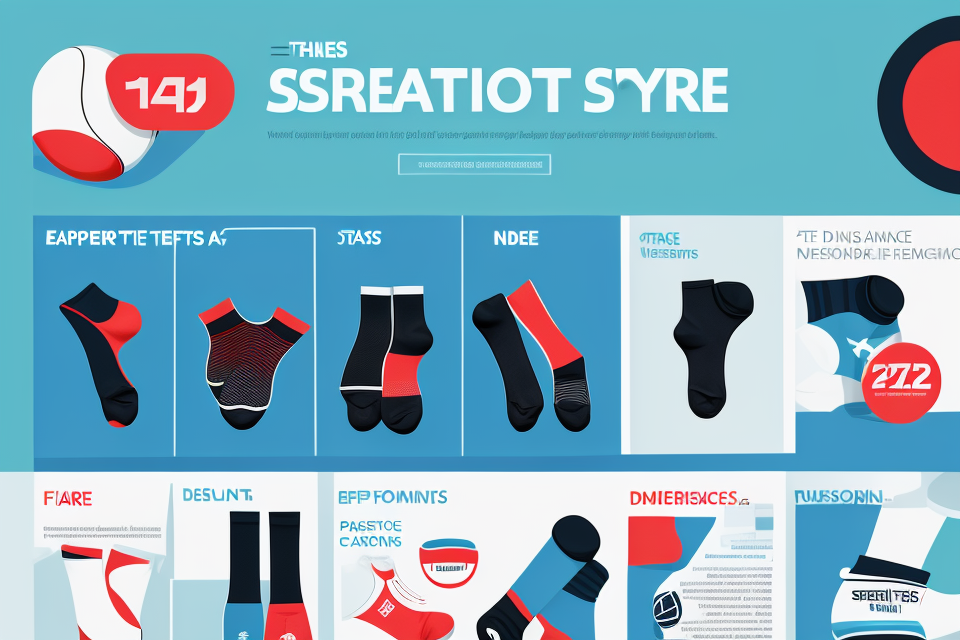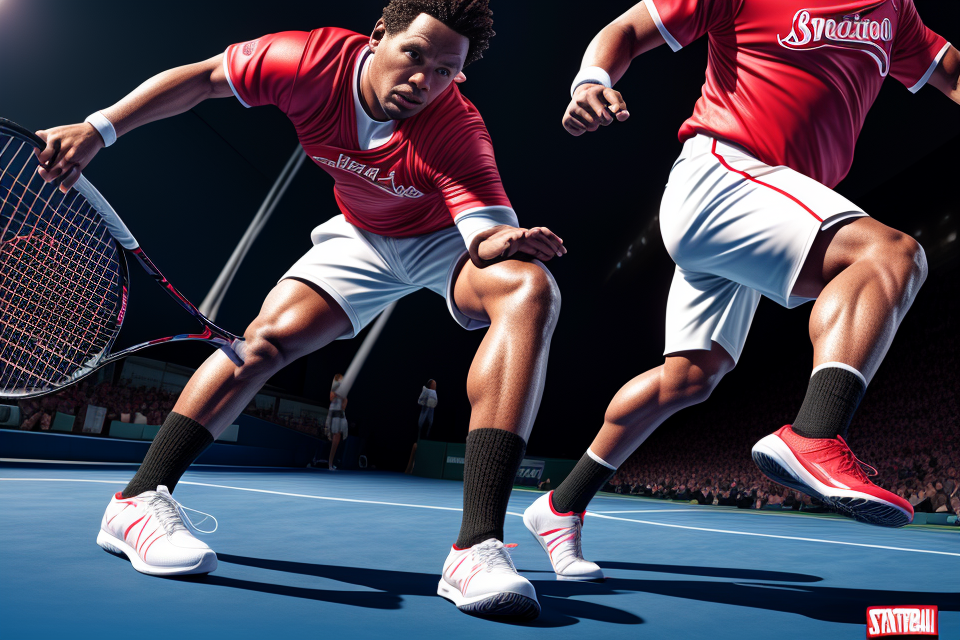Are you curious about why some tennis players wear two pairs of socks while playing? Well, you’re not alone! This intriguing topic has sparked much debate among tennis enthusiasts. Some believe that wearing two pairs of socks provides better support and reduces the risk of blisters, while others argue that it’s simply a personal preference. In this comprehensive guide, we’ll delve into the world of tennis socks and uncover the truth behind this fascinating topic. Whether you’re a seasoned player or a tennis novice, this guide will provide you with all the information you need to make an informed decision about your footwear. So, let’s get started and discover the secrets behind the world of tennis socks!
Why Do Tennis Players Wear Two Pairs of Socks?
To Prevent Blisters and Foot Pain
Blisters and foot pain are common issues that tennis players face during matches. The repetitive motion of running, changing direction, and pivoting on the court can cause friction and pressure on the feet, leading to blisters and pain. Tennis players often wear two pairs of socks to prevent these issues and ensure that they can perform at their best throughout the match.
How Socks Absorb Sweat and Protect the Feet
Sweat is a natural response to physical activity, and tennis players generate a lot of it. Sweat can cause the feet to become slippery and uncomfortable, which can increase the risk of blisters and foot pain. Wearing two pairs of socks can help absorb sweat and keep the feet dry, reducing the risk of blisters and foot pain. Additionally, wearing two pairs of socks can provide extra cushioning and support for the feet, reducing the impact of each step and protecting the feet from the repetitive motion of the game.
The Benefits of Wearing Two Pairs of Socks
Wearing two pairs of socks can provide a number of benefits for tennis players. In addition to preventing blisters and foot pain, wearing two pairs of socks can help reduce the risk of other foot problems, such as fungal infections and plantar fasciitis. The extra layer of socks can also provide additional support and stability for the feet, reducing the risk of sprains and strains. Additionally, wearing two pairs of socks can help regulate body temperature, keeping the feet warm in cooler conditions and cool in hotter conditions.
Overall, wearing two pairs of socks is a simple but effective way for tennis players to protect their feet and ensure that they can perform at their best throughout the match.
Different Types of Socks for Tennis
Tennis is a sport that requires players to be on their feet for extended periods, often running back and forth across the court. As such, it’s essential to have the right footwear to ensure comfort and support. While some players opt for tennis shoes, others prefer to wear socks to provide additional cushioning and support.
Cushioning Socks
Cushioning socks are designed to provide extra comfort and support for the feet. These socks typically have a thick layer of padding in the sole that cushions the feet from impact and shock. Some cushioning socks also have arch support to help maintain the natural shape of the foot and reduce the risk of foot pain.
Cushioning socks are ideal for players who spend long hours on the court, as they can help reduce fatigue and prevent foot pain. They are also suitable for players who have flat feet or high arches, as they provide extra support to help maintain proper foot alignment.
Non-Cushioning Socks
Non-cushioning socks, on the other hand, are designed to provide minimal support and cushioning. These socks are often preferred by players who already have good arch support in their feet and just need a little extra padding to reduce the risk of blisters and other foot injuries.
Non-cushioning socks are ideal for players who play in short bursts or have a more casual playing style. They are also suitable for players who wear custom orthotics or other foot supports, as they can provide a comfortable base layer for these devices.
Overall, choosing the right type of socks for tennis depends on individual preferences and playing styles. Cushioning socks provide extra support and comfort for players who spend long hours on the court, while non-cushioning socks are ideal for players who need minimal support and just want a little extra padding.
Choosing the Right Socks for Your Foot Type
When it comes to selecting the right socks for tennis, it’s important to consider your foot type. Different foot types require different levels of support and cushioning. By choosing the right socks, you can prevent foot pain and injuries, and ensure that you have the best possible performance on the court.
Flat Feet
Flat feet, also known as “fallen arches,” occur when the arch of the foot is absent or very low. This can cause a range of foot problems, including pain, inflammation, and plantar fasciitis. When selecting socks for flat feet, look for those that provide extra cushioning and support in the arch area. Cushioned socks can help absorb the shock of each step, reducing the impact on your feet and helping to prevent pain.
High Arches
High arches, on the other hand, can cause a range of problems, including plantar fasciitis, heel pain, and ankle sprains. When selecting socks for high arches, look for those that provide extra cushioning and support in the heel and arch areas. Good arch support can help distribute weight evenly across the foot, reducing the risk of injury and improving overall foot comfort.
When choosing socks for your foot type, it’s important to consider the material as well. Some materials, such as cotton and wool, are naturally moisture-wicking and breathable, while others, such as synthetic fibers, can provide extra support and compression. It’s important to find a balance between support, comfort, and breathability when selecting tennis socks.
By choosing the right socks for your foot type, you can ensure that your feet stay comfortable and pain-free throughout your tennis match. Whether you have flat feet or high arches, there are socks available that can provide the support and cushioning you need to perform your best on the court.
Proper Sock Care for Optimal Performance
- Washing and Drying Socks
- It is important to wash socks regularly to prevent the buildup of sweat and bacteria, which can cause foot odor and unpleasant smells.
- It is recommended to wash socks in cold water to preserve their shape and elasticity.
- It is also recommended to use a gentle detergent to avoid damaging the fibers of the socks.
- Socks should be dried on a flat surface or on a clothesline, not in a dryer, to prevent shrinkage.
- Rotating Socks
- Rotating socks means alternating between different pairs of socks during matches to prevent overuse and to allow each pair to dry properly.
- This practice helps to keep the feet dry and comfortable throughout the match, reducing the risk of blisters and other foot injuries.
- Rotating socks also helps to prolong the life of the socks by reducing wear and tear on the fibers.
- Players may choose to bring multiple pairs of socks to a match to ensure they have a clean and dry pair available at all times.
Tennis Shoes and Foot Comfort
Importance of Tennis Shoes in Foot Comfort
Support and Cushioning
In tennis, the type of shoes a player wears can greatly impact their foot comfort and overall performance on the court. A good pair of tennis shoes should provide the necessary support and cushioning to help players maintain their footing and avoid injuries.
Support
One of the most important aspects of tennis shoes is the level of support they provide. A good pair of tennis shoes should have a sturdy sole that helps to absorb the impact of each step and keep the player’s feet stable on the court. This is especially important for players who are on their feet for long periods of time and need to maintain their footing during quick movements and changes of direction.
Cushioning
Another important aspect of tennis shoes is the level of cushioning they provide. A good pair of tennis shoes should have a soft, comfortable lining that helps to absorb the impact of each step and reduce the risk of foot fatigue and injury. This is especially important for players who are on the court for long periods of time and need to maintain their footing during quick movements and changes of direction.
In addition to providing support and cushioning, a good pair of tennis shoes should also be flexible and provide good traction on a variety of court surfaces. These features, along with support and cushioning, are essential for any player looking to improve their foot comfort and overall performance on the court.
Choosing the Right Tennis Shoes for Your Foot Type
Selecting the right tennis shoes is crucial for foot comfort and performance on the court. The ideal tennis shoes should cater to the unique characteristics of your feet. Here’s a detailed guide on how to choose the right tennis shoes based on your foot type:
- Flat feet are characterized by a low arch or an absence of an arch. Individuals with flat feet may experience discomfort and pain in traditional tennis shoes due to the lack of support.
-
To find the right tennis shoes for flat feet, look for the following features:
- Rigid Support: Tennis shoes with a sturdy, supportive structure are ideal for those with flat feet. The shoes should provide ample stability and prevent the foot from rolling inward.
- Midsole Cushioning: Opt for shoes with a cushioned midsole to absorb the impact of each step and reduce the strain on your feet.
- Flexibility: Ensure that the shoes offer a sufficient range of motion while maintaining the necessary support.
-
High arches are characterized by an exaggerated curve in the foot’s inner part. People with high arches may require more cushioning and support in their tennis shoes to maintain stability and reduce discomfort.
- To find the right tennis shoes for high arches, consider the following features:
- Midsole Cushioning: Opt for shoes with a thick, cushioned midsole to provide ample shock absorption and support for the arch.
- Stability: Look for shoes with a supportive design that helps maintain the natural alignment of your foot, preventing excessive pronation (rolling inward).
- Flexibility: While providing ample support, the shoes should also offer a comfortable range of motion for natural foot movement.
In conclusion, choosing the right tennis shoes for your foot type is essential for maximizing comfort and performance on the court. By considering the unique needs of flat feet or high arches, you can select the best tennis shoes to support your game.
Tennis Shoe Sock Combinations for Maximum Comfort
Socks for High Arches
Players with high arches may benefit from socks that provide extra cushioning and support in the arch area. Socks with arch support can help distribute pressure more evenly across the foot, reducing the risk of pain and discomfort. Additionally, moisture-wicking properties can help keep feet dry and odor-free during long matches.
Socks for Flat Feet
Players with flat feet may experience discomfort and pain due to the lack of arch support in their feet. Socks with built-in arch support can help provide the necessary support to reduce pain and improve comfort. Additionally, socks with a cushioned sole can help absorb shock and reduce impact on the feet during intense play.
In conclusion, choosing the right socks for your foot type is crucial for maximum comfort during tennis matches. By considering the unique needs of players with high arches or flat feet, tennis shoe sock combinations can provide the necessary support and cushioning to ensure comfort and reduce the risk of pain and discomfort.
Foot Health and Maintenance for Tennis Players
Foot Strengthening Exercises
Foot strength is crucial for tennis players as it helps improve stability, balance, and reduces the risk of injuries. The following exercises can be incorporated into a tennis player’s routine to strengthen their feet:
Calf Raises
Calf raises are an effective exercise to strengthen the calf muscles, which are essential for proper foot stability. To perform calf raises, follow these steps:
- Stand with your feet shoulder-width apart, toes pointing forward.
- Raise up onto the balls of your feet, lifting your heels off the ground.
- Pause at the top of the movement, then slowly lower your heels back down to the ground.
- Repeat for 10-15 repetitions, with 2-3 sets.
Toe Raises
Toe raises are an excellent exercise to strengthen the muscles in the toes and feet. To perform toe raises, follow these steps:
- Sit on the ground with your legs extended in front of you.
- Place a small towel or a resistance band around your toes.
- Slowly lift your toes, curling them up towards your shins.
- Pause at the top of the movement, then slowly lower your toes back down.
- Repeat for 10-15 repetitions, with 2-3 sets.
These exercises can be done regularly to improve foot strength and prevent injuries. Additionally, incorporating exercises that target the leg muscles, such as squats and lunges, can also help improve foot stability and reduce the risk of injuries.
Foot Massages and Stretches
Foot massages and stretches are an essential part of foot health and maintenance for tennis players. Proper care for the feet can help prevent injuries and improve overall performance on the court.
Foot Rolling
Foot rolling is a technique that involves using a small ball or a roller to massage the feet, specifically the plantar fascia, which is a thick band of tissue that runs along the bottom of the foot. This technique can help to improve circulation, reduce pain and stiffness, and increase flexibility in the feet.
Toe Stretching
Toe stretching is another effective technique for improving foot health and preventing injuries in tennis players. This involves stretching the toes individually and then progressing to more challenging stretches that work multiple toes at once. Regular toe stretching can help to increase flexibility, improve balance, and reduce the risk of toe injuries.
Overall, foot massages and stretches are crucial for maintaining foot health and preventing injuries in tennis players. By incorporating these techniques into their daily routine, players can improve their overall performance on the court and enjoy a more comfortable and successful tennis experience.
Addressing Common Foot Problems in Tennis
Plantar Fasciitis
Plantar fasciitis is a common foot problem among tennis players, especially those who spend long hours on the court. It is caused by inflammation of the plantar fascia, a band of tissue that runs along the bottom of the foot. This condition can cause pain and discomfort in the heel and arch of the foot, making it difficult for players to move around on the court.
To prevent plantar fasciitis, tennis players should make sure to stretch their feet and legs before and after each match or practice session. They should also wear proper footwear that provides adequate support and cushioning. In addition, ice packs can be applied to the affected area to reduce inflammation and alleviate pain.
If plantar fasciitis does develop, players should seek medical attention from a sports medicine specialist or podiatrist. Treatment may include rest, ice, physical therapy, and in some cases, medication or surgery.
Tennis Elbow
Tennis elbow, also known as lateral epicondylitis, is a common injury among tennis players. It is caused by repetitive motions of the wrist and arm, such as those involved in serving and hitting the ball. The condition results in pain and inflammation in the elbow and forearm, making it difficult for players to grip their racquet and perform at their best.
To prevent tennis elbow, players should make sure to warm up properly before each match or practice session. They should also use proper technique when hitting the ball and avoid using excessive force or repetitive motions. In addition, strengthening exercises for the forearm and shoulder muscles can help prevent tennis elbow.
If tennis elbow does develop, players should seek medical attention from a sports medicine specialist or orthopedic doctor. Treatment may include rest, ice, physical therapy, and in some cases, medication or surgery.
Preventing Foot Injuries on the Tennis Court
Proper Footwear
Foot injuries are common among tennis players due to the repetitive and strenuous movements on the court. To prevent foot injuries, it is essential to wear proper footwear. The ideal tennis shoes should have a sturdy and supportive sole that can withstand the impact of running and sudden stops. The shoes should also have a good grip on the court to prevent slips and falls. Additionally, a well-fitting shoe that conforms to the shape of the foot can help reduce the risk of foot injuries.
Warm-Up and Cool-Down Techniques
A proper warm-up and cool-down routine is crucial for preventing foot injuries on the tennis court. Before starting a match or practice session, it is important to warm up the muscles and joints in the feet and legs. This can be done by walking or jogging slowly around the court, doing some light stretching, and gradually increasing the intensity of movements. After the match or practice session, it is equally important to cool down by stretching the muscles and joints in the feet and legs. This helps to prevent stiffness and soreness and promotes proper blood flow to the feet.
Foot Health and Maintenance Tips for Tennis Players
Maintaining good foot health is essential for tennis players to avoid foot injuries and keep playing at their best. Here are some tips for foot health and maintenance:
- Keep the feet clean and dry to prevent infections and fungal growths.
- Moisturize the feet regularly to keep the skin soft and prevent cracking.
- Wear socks that wick moisture away from the feet to prevent blisters and foot odor.
- Stretch the feet and legs regularly to maintain flexibility and prevent stiffness.
- Avoid playing on hard courts for long periods without proper footwear and support.
- Seek medical attention if you experience any pain or discomfort in the feet or legs during or after a match.
The Psychological Impact of Foot Comfort on Tennis Performance
Confidence and Mental Clarity
The state of one’s feet can have a significant impact on their overall confidence level during a tennis match. Players who experience discomfort or pain in their feet may become distracted and preoccupied with the discomfort, which can negatively affect their performance.
Minimizing Distractions
By ensuring that their feet are comfortable and well-cared for, tennis players can minimize potential distractions and stay focused on the game. This is particularly important during high-pressure situations, such as serve returns or crucial points in a match, where players need to be fully present and mentally sharp.
In addition to physical discomfort, foot issues such as blisters or plantar fasciitis can also lead to mental fatigue and frustration, making it difficult for players to maintain their concentration and stay motivated. By addressing these issues proactively and prioritizing foot health, tennis players can improve their mental clarity and reduce the risk of distractions that can negatively impact their performance.
Key Takeaways
- Regularly inspecting and caring for your feet is crucial for preventing injuries and maintaining optimal performance on the court.
- Socks play a vital role in protecting and supporting the feet during tennis matches and practices.
- Tennis players may wear two pairs of socks to enhance foot comfort and reduce the risk of blisters and other foot-related issues.
- The choice of socks depends on individual preferences, playing surfaces, and foot conditions.
- It is important to consult with a podiatrist or sports medicine professional to determine the best foot care regimen for your specific needs.
- Investing in high-quality footwear and socks can significantly improve foot health and overall performance in tennis.
Final Thoughts
Proper foot health and maintenance are crucial for tennis players to ensure optimal performance and prevent injuries. It is essential to invest in high-quality footwear and socks that provide the necessary support and cushioning for the feet.
In addition, it is recommended to take regular breaks during practice and matches to allow the feet to rest and recover. Stretching and massaging the feet can also help to alleviate any discomfort and prevent injuries.
It is important to remember that every individual’s foot health needs are different, and what works for one player may not work for another. It is essential to listen to one’s body and make adjustments to footwear and foot care routines as needed.
Overall, prioritizing foot health and maintenance is essential for any tennis player looking to perform at their best and avoid injuries on the court.
FAQs
1. Do tennis players wear two pairs of socks?
Yes, many tennis players wear two pairs of socks to ensure optimal foot comfort during matches. Wearing two pairs of socks can help absorb sweat, reduce blisters, and provide additional cushioning for the feet. However, some players may choose to wear only one pair of socks or even go without socks at all, depending on their personal preference and the conditions of the court.
2. Why do tennis players wear two pairs of socks?
Tennis players wear two pairs of socks to help manage the moisture and heat that can build up on the court. Sweat can cause blisters and discomfort on the feet, and wearing two pairs of socks can help absorb excess sweat and keep the feet dry. Additionally, the extra layer of socks can provide additional cushioning and support for the feet during long matches.
3. Can wearing two pairs of socks affect a player’s performance?
Wearing two pairs of socks can affect a player’s performance in a few ways. Firstly, the added layers of socks can make it more difficult to move and change direction quickly on the court. Additionally, if the socks are too bulky or cumbersome, they may hinder a player’s ability to grip the court surface and make shots accurately. However, many players find that the benefits of wearing two pairs of socks outweigh any potential drawbacks, as long as the socks are fitted properly and do not impede their movement.
4. What type of socks do tennis players wear?
Tennis players typically wear specialized socks designed for the sport. These socks are usually made from moisture-wicking materials that help keep the feet dry and comfortable during play. Some players may also prefer socks with added cushioning or support to help prevent blisters and other foot injuries. Ultimately, the choice of socks will depend on the player’s personal preference and the conditions of the court.
5. Can wearing two pairs of socks cause any problems for the feet?
Wearing two pairs of socks can cause a few potential problems for the feet, particularly if the socks are too tight or constricting. This can lead to blisters, calluses, or other foot injuries. Additionally, wearing two pairs of socks can make it more difficult to move and change direction quickly on the court, which may affect a player’s performance. However, many players find that the benefits of wearing two pairs of socks outweigh any potential drawbacks, as long as the socks are fitted properly and do not impede their movement.



